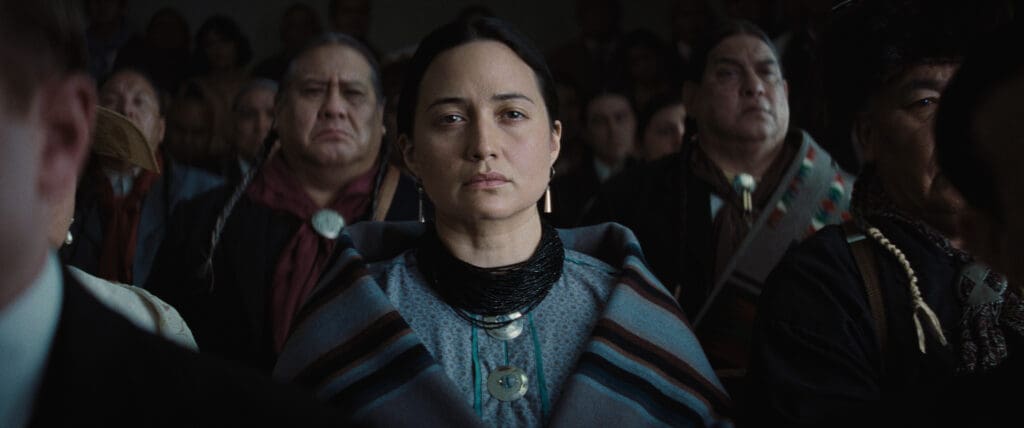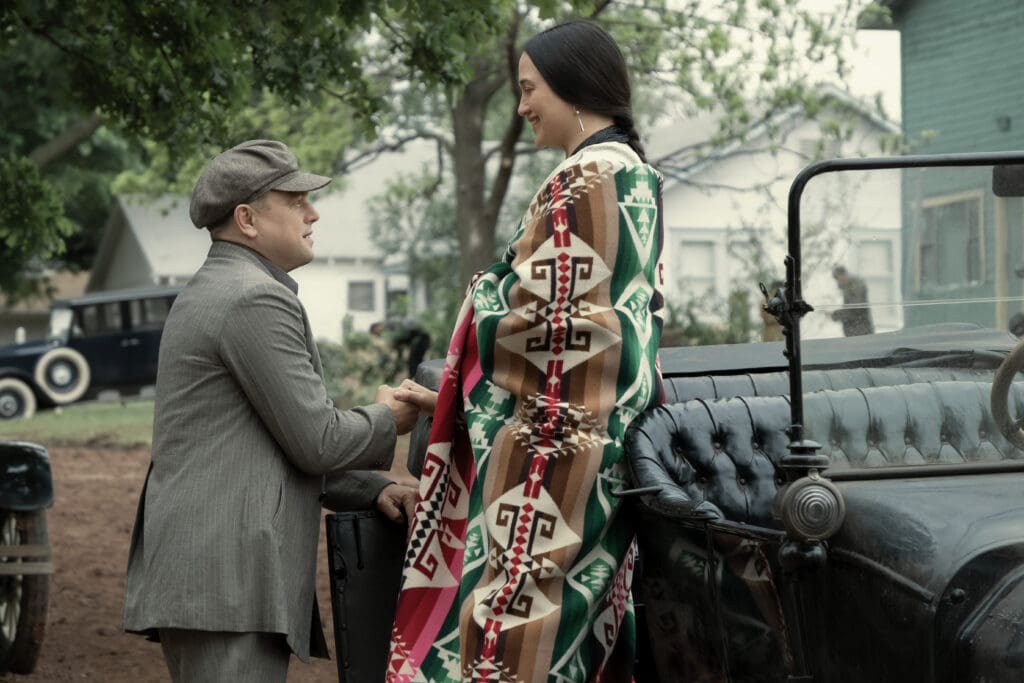Killers of the Flower Moon, Martin Scorsese’s Oscar-nominated film, begins with Osage men somberly performing a traditional pipe ceremony. It cuts to a slow-motion scene of tribal members exuberantly dancing in a field, crude oil gushing around them. Get it? Indians are sacred, ancient in their care and devotion to the natural world. Suddenly, though, they will be challenged by settler wealth and greed.
In little time, we are then introduced to Scorsese’s central characters: Mollie Kyle, played by American Indian actress Lily Gladstone; Ernest Hale (Robert De Niro); and Ernest Burkhart (Leonardo DiCaprio). Scorsese, with his co-writer Eric Roth, quickly lays the groundwork for viewers to understand the Osage predicament as wards of non-Indian guardians over lease contracts and royalties regarding headrights. Hale is a monster the minute we meet him. Burkhart, for his part, states again and again that he loves money; something of a dunce, he takes orders from his murderous uncle, seemingly without hesitation. Both De Niro and DiCaprio perform with perpetual downturned mouths, lest viewers forget the characters are Very Bad Men. In David Grann’s 2017 book that is the basis of the movie, the reader learns of the men’s machinations late in the narrative—and it comes as a shock. In the movie, by contrast, we are early witnesses to Hale and Burkhart’s step-by-step scheming.
Grann divides Killers of the Flower Moon into three sections. The first, titled “The Marked Woman,” explains the history of Osage allotments, noting that most Osage citizens were deemed “incompetent” by the federal government. The Osage were allowed ownership only of the minerals below their lands; their assigned guardians advised and ultimately made decisions, notably over how much money they gave their wards from the profits. “Full bloods” were always assigned a guardian.
Mollie Burkhart (née Kyle) was an enrolled member of the Osage Nation in 1921. As the movie shows, Mollie’s three sisters, Anna, Minnie and Rita, as well as their mother, Lizzie, are murdered or die mysteriously. It’s Tom White, an FBI agent, who puts the pieces together, implicating Hale and his nephew Burkhart, who is married to Mollie. “The Evidence Man,” the second and longest section of Grann’s book, focuses on White’s work, amplifying the whodunit aspect of the story. An ambitious J. Edgar Hoover, looking to make a name for himself and the newly renamed Bureau of Investigation, appoints White to crack the increasingly well-publicized disappearances and murders of the oil-rich Osage Indians. White does it with aplomb.
In the last section of his book, aptly titled “The Reporter,” Grann reflects on his investigative work and shares interviews with Osage descendants, concluding that despite White’s success uncovering the murders of Mollie’s family, justice for the Osage had hardly been served. Countless cases of missing and murdered Osage have never been solved.
Grann portrays White as noble and smart, a hero. Hale and Burkhart are the villains, and the Osage are the victims. The author’s focus was aided, if not influenced, by available government records that told White’s story. And Grann must be commended for his superlative work in relating, as White discovered, that “virtually every element of [white] society was complicit in the murderous system.”
Still, I wish I could have learned more about the story from an Osage point of view, if not from Grann, then in Scorsese’s movie. In the film, after the brutal murders of Mollie’s two sisters and the illnesses and death or her mother and third sister, the question remains as to when she will put the pieces together and condemn her husband; this keeps the focus on Mollie and her relationship to Burkhart. As portrayed by Gladstone, a best actress Oscar nominee, she is good and kind, but she spends too much of the picture wide-eyed in disbelief or crying in sorrow.
As film critic Andrew Pulver of the Guardian has written, Scorsese, moving away from a detective story, is able to show Ernest and Mollie’s relationship “scrutinized in forensic detail and invested fully with the ambivalence both are assumed to feel.” We do see glimpses throughout of Burkhart’s guilt; he is the father of Mollie’s children, after all. And Mollie, at the end of the picture, sees fully that Burkhart has been lying to her. But earlier, just after she’s been treated in the hospital for what turns out to be strychnine poisoning, she allows Burkhart to ply her with another shot. And before that, just as in Grann’s book, she suspects she is being poisoned. She’d written a letter to the local priest suspecting as much. Who else besides Burkhart has been giving her shots, supposedly insulin? White, played by Jesse Plemons, appears late in the three-hour movie; he cracks the case but never steals the show, a principal difference from Grann’s book. Yet, except for White, the Osage and the settlers are the same—victims and villains.
Hollywood and the publishing industry often play on stereotypes of the American Indian, either as a wagon burner or fallen nature god. The wagon burner, as in countless Westerns, is a savage whose defeat in conflicts of power and territory is justified. The fallen nature god is pitied as a result of defeat. Despite Scorsese’s best intentions—including the director’s acknowledgment in the film’s coda that his is but a non-Indigenous person’s attempt at this story and not the definitive one—the Osage are portrayed as victims at the hands of aptly portrayed murderous settlers. The danger is that even while we are pitied and others attempt to make amends for a shameful past, too often the ways of that past remain invisible in the present. Ambivalence, maybe, but what of resilience? Not long after Burkhart’s conviction, Mollie remarried and happily raised her two surviving children from the man. She became active once more in the Catholic Church and socialized with many friends. It’s good that the Osage story was told in Grann’s book and Scorsese’s film. But what might new and Indigenous versions of this story and others look like? Couldn’t the American Indian have more agency? Gladstone, for instance, gives a searing performance as a woman caring for her niece after her sister’s disappearance on the Seneca-Cayuga Reservation in Seneca-Cayuga citizen Erica Tremblay’s Fancy Dance, which premiered at Sundance in 2023. More than a year passed, however, before the film was finally picked up by a Hollywood distributor. It’s not people’s pity that guaranteed our survival. It’s our ingenuity and endurance.
Greg Sarris is the Tribal Chairman of the Federated Indians of Graton Rancheria, in Sonoma County, California. His most recent book is Becoming Story: A Journey Among Seasons, Places, Trees, and Ancestors. Heyday will also publish his forthcoming story collection, The Forgetters, in April.


